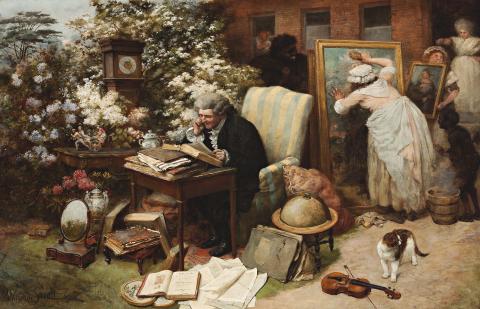SPRING CLEANING, 1892
WILLIAM STRUTT
oil on canvas
66.5 x 102.5 cm
signed lower left: William Strutt
Alfred William Strutt, London, purchased 1892
Private collection, France
27th Garden Party Auction, Rouillac, Château d'Artigny, Montbazon, France, 7 June 2015, lot 149
Private collection, Melbourne
Japanese Gallery, Bond Street, London 1893
11th Spring Exhibition, Corporation Art Gallery, Derby, 1894, cat. 27
Summer Exhibition, Corporation Art Gallery, York, 1895, cat. 559
Chester, A., ‘The Art of Mr. William Strutt’, The Windsor Magazine, London, vol. 36, no. 215, November 1912, p. 623 (illus.)
Curnow, H., The Life and Art of William Strutt: 1825 – 1913, Alister Taylor, Martinborough, New Zealand, 1980, cat. 144, pp. 66, 221 (illus.)
In Australian late colonial art, William Strutt is best known for his history paintings. Foremost among the very memorable are Black Thursday, February 6th. 1851, 1864 (collection: State Library of Victoria, Melbourne), a magnificent panorama of panic as all life flees before the raging bushfires, and Bushrangers, Victoria, Australia, 1852, 1887 (collection: University of Melbourne, Melbourne) imaging those who were once busy on Melbourne’s St. Kilda Road. Both were painted after Strutt returned to England in 1862. Exhibiting at the London Royal Academy and other prestigious places, Strutt showed great versatility and achieved considerable success with his genre paintings, especially those period pictures devoted to seventeenth and eighteenth-century subjects, invariably full of satire and wry humour.1 Stocks Closed Firmly with an Upward Tendency, 1889 (collection: Kirklees Metropolitan Council, Yorkshire) carried informative additional titles – Love Laughs at Locks and Bars and Bumble Outwitted. Taming a Shrew, exhibited in the 1891 London Royal Academy, needed no further explanation.
The satiric Spring Cleaning, 1892, however, might benefit from an additional verbal hint. When shown at Larkin’s Japanese Gallery in 1893, one critic observed, ‘‘Spring Cleaning’, W. Strutt, is another delightfully humorous subject, absolutely novel’.2 Spring, as a time of renewal in nature and the affairs of man, is occasioned by bounteous flowers on the one hand and a serving maid busily scrubbing a large oil painting on the other. The novelty of the satire extends through the placement of a watchful chimney sweep and his boy on either side of the scrubbed picture, the two blackened by trade, as the painting was by time. As a wry twist of William Hogarth’s engraving Time Smoking a Picture, 1761, Strutt’s commentary is likewise directed at the eighteenth-century English art connoisseurs’ enthusiasm for any old master painting, believing that time itself endowed quality.3 Time and its passing is emphasised elsewhere by the prominent placement of a long case clock incongruously set midst the bushes in full bloom. And in the foreground, the dressing glass with its arboreal reflections suggests art holding up a mirror to nature. 4 For the bewigged gentleman enslaved by his old tomes, the outdoor setting offers a present means towards enlightenment, clearing away the printed cobwebs to observe the world around him. And the cat? Strutt seldom created a genre painting without the presence of a dog or cat, or two.
Heather Curnow, in her extensive monograph on Strutt, describes Spring Cleaning as ‘…a tour de force in the painting of figures and a variety of still-life objects out of doors’.5 Strutt’s mastery of realism is profound, especially when applied to amusing ends with serious intent. While modern art has long led the eye and mind away from narrative, replaced by its own lengthy theoretical explanations, much aesthetic and intellectual pleasure can be gained in unraveling a pictorial story. As in Spring Cleaning, the viewer who looks long and carefully is readily rewarded.
1. Curnow, H., op. cit., p. 62
2. ‘Art Notes’, [1893?], unnamed and undated newspaper article in William Strutt, ‘Press Cuttings 1864 – 1902’, private collection, quoted in Curnow, ibid., p. 221
3. In Time Smoking a Picture, Time blackens the painting with smoke from his pipe as he sits on a sculpture he has destroyed.
4. Shakespeare, ‘Hold as ‘twere the mirror up to nature, to show virtue her own image’. Hamlet to the players, Hamlet, act 3, sc. 2, l. 38 – 9
5. Curnow, op. cit., p. 65
DAVID THOMAS
